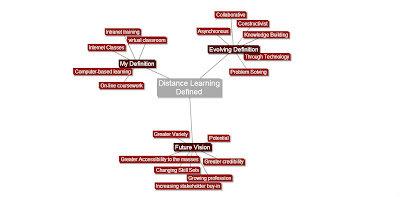I am in the third week of my Distance Learning course at Walden University as part of my MS in Instructional Design and Technology and have been asked to look into an opportunity to use distance learning technology to fit the needs of a specific learning context in a particular scenario. The scenario I chose is presented below and I will present a short narrative explaining a possible technology tool that will present a training or educational solution to the scenario.
Example 3: Asynchronous Training
In an effort to improve its poor safety record, a biodiesel manufacturing plant
needs a series of safety training modules. These stand-alone modules must
illustrate best practices on how to safely operate the many pieces of heavy
machinery on the plant floor. The modules should involve step-by-step processes
and the method of delivery needs to be available to all shifts at the plant. As
well, the shift supervisors want to be sure the employees are engaged and can
demonstrate their learning from the modules. (Walden University, 2010).
In researching possible solutions for this scenario I chose to use Moodle.com as a distance learning tool that would present a potential learning solution through technology. This Course Management System (CMS) is a great example of a CMS that has the capabilities that allows designers to create and install pedagogical content, whether it is a teacher or other technical staff member as the designer (Simonson, Smaldino, Albright, & Zvacek, 2009, p. 239). Moodle can be used to design stand-alone modules intended to address a variety of educational solutions. In this case, How to operate vital pieces of equipment within a business’ safely or according to prescribed safety protocols. In this scenario there is an obvious need for an asynchronous environment that will allow multiple shifts to access the training module(s).
Moodle.com is an open source CMS that “can increase real-time collaboration between learners, especially in courses that are fully asynchronous” (Beldarrain, 2006, p. 143). For this solution system, it is vital to have various components in place to include but is not restricted to course management elements like syllabi, calendars, announcements, various instructions, objectives, rosters, and gradebooks (Simonson, et al., 2009). To further enhance the experience, the solution should include course readings, presentations, communications, project space, assessments, assignment submissions, evaluation, and any of the various Web 2.0 tools currently available(Simonson, et al., 2009). In doing so Moodle.com satisfies any and all of these requirements by allowing designers to create “activity modules (such as forums, databases and wikis) to build richly collaborative communities of learning around their subject matter (in the social constructionist tradition)” or simply to present content and traditionally “assess learning using assignments or quizzes” (http://moodle.org/about/). In utilizing Web 2.0 technology available in the design of a Moodle site, designers can facilitate “high levels of student Intellectual engagement – with content, with their instructors, and with each other – that hallmark the learner-centered instructional paradigm (Simonson, et al., 2009, p. 244). Ultimately, “collaboration in either asynchronous or synchronous learning environments allows learners to practice real-world skills that are applicable to the workplace” and for this scenario I believe Moodle can provide this (Beldarrain, 2006, p. 144).
In order to further support my assertion that Moodle would be a viable CMS solution for training/educating employees on safe equipment operation protocols I offer up testimonials, critiques, or reviews of Moodle in the real world. For example, arguably Moodle is user friendly with “lots of functionality” and it has “instructor control over look and features available within a course” (Taylor, 2006). Another positive aspect of Moodle illustrates how “novice users can spend two hours or less and have their Moodle classroom sites up and running with ease—including modifying the site colors, educational modules, navigation systems, and features” (Driscoll). In another review of Moodle it was illustrated in an online English as a Second Language course in Japan, it was noted that “the lesson module allows you to provide information to the students in small chunks, ask a comprehension question about what they have just learned and then conditionally branch out depending on their response” (Robb, 2004).
On a personal note I have used Moodle to take part in an asynchronous learning module for the school district I work for. In this learning module intended to introduce the faculty countywide district to an new initiative to be implemented in the schools, we were asked to navigate through various readings and simulations then take a series of quizzes, which we had opportunities to fix our mistakes and resubmit our answers. All of which was time stamped for the administrators to track student participation time and time spent on tasks. Not only were we exposed to a real time example of the initiative but we were assessed on the knowledge gained in doing so and through various reading selections. In fact there was a final exam that assessed the outcomes in comparison to the learning objectives of the exercise. Simply because of this personal experience and the evidence presented in this posting, I would advocate the use of Moodle to design a learning solution in a this CMS or Virtual Learning Environment (VLE) to provide an asynchronous learning situation for the target audience.
References:
Beldarrain, Y. (2006). Distance education trends: Integrating new technologies to foster student interaction and collaboration. Distance Education, 27(2),139–153.
Driscoll, D.L., Message posted to Review of Moodle Course Management System. Archived at
http://www.bgsu.edu/cconline/Web_2_0_Reviews/Moodle_Driscoll/practicality.html
Robb, T.,( September 2004). Moodle: a virtual learning environment for the rest of us. Message posted to TESL-EJ, Teaching English as a Second Language or Foreign Language, archived at http://tesl-ej.org/ej30/m2.html
Simonson, M., Smaldino, S., Albright, M., & Zvacek, S. (2009). Teaching and learning at a distance: Foundations of distance education (4th ed.) Boston, MA: Pearson.
Taylor, V., (2006). Moodle - faculty review. Retrieved September 26, 2010, from
http://faculty.deanza.edu/taylorvalerie/stories/storyReader$489
What is Moodle? (2010). Retrieved from http://moodle.org/about/
Walden University. (2010). Application: Blog—Selecting Distance Learning Technologies. Retrieved from http://sylvan.live.ecollege.com/ec/crs/default.learn?CourseID=4442081&Survey=1&47=6201564&ClientNodeID=984650&coursenav=1&bhcp=1
Making the Case for Employee Development
12 years ago




